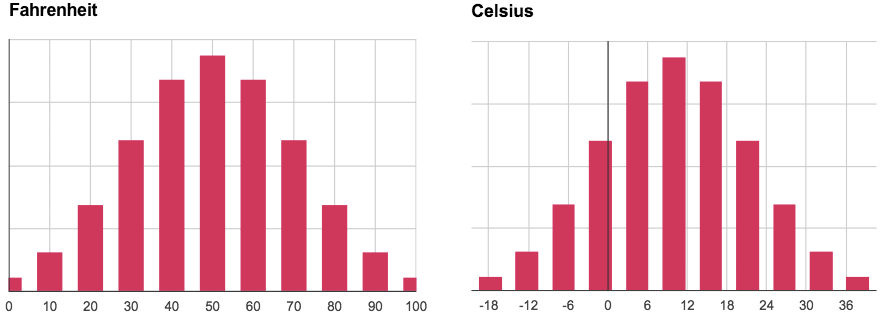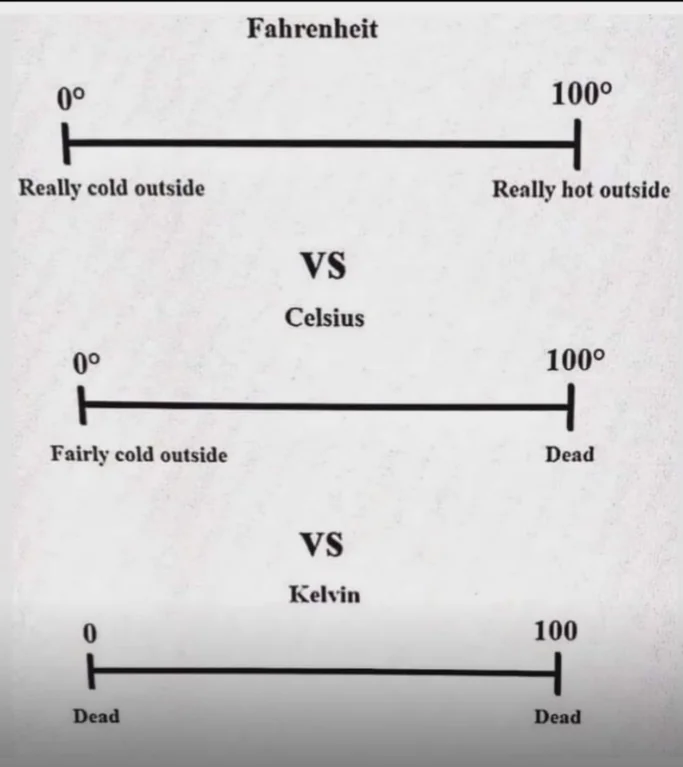Fahrenheit is Better for Humans - One International Standard should not Rule Them All!
I recently went to Montreal, where I was immersed in the Metric world again. Kilometers distances to everywhere, Celsius temperatures in every weather prediction, and oddly Imperial Gallons of Gasoline (because of their English heritage - the Queen of England is still imprinted on their Money), where they get 1.2 of our U.S. Gallons. I had incorrectly assumed they sold it in Liters, and had converted to a Kilometers per Liter system of gauging milage, along with the rest of the Metric system...
However, while I do think that many of our old U.S. standard measurements will eventually become silently defunct (do you buy soda in half-gallons, or liters?). Just because certain metric measurements are superior to traditional measurements (centimeters has more detail than inches), this doesn’t mean that every part of the metric system is superior. As we're coming up on the 300th anniversary of Fahrenheit's invention, I thought I'd use this opportunity to come up with four quick responses to why Fahrenheit is better than Celsius as a standard of temperature measurement for the World!
➊ Fahrenheit was First! We love First Place Winners!
Daniel Gabriel Fahrenheit established this unit of temperature measurement in 1724. He was a physicist, and basing his work on Ole Christensen Rømer, who had invented the first calibrated scale i.e. a numbering system between two observable points. The Celsius scale was invented 24 years later in 1742!
As for the United States adoption (less than 20 years from declaring their own independence) then secretary of state Thomas Jefferson reviewed the matter and felt reluctant to push for the decimal-based Metric system in 1790. The Imperial system was already well-established everywhere from previous English rule, and Metric was still a fledgling standard born in France.
➋ Degrees is a measure of Resolution. We love higher Resolution.
While Rømer pioneered non-decimal-based temperature scales, Fahrenheit was just following suit, and ensured it by multiplying each of Rømer's values by four in order to eliminate fractions and increase the granularity of the scale.
Do you know how to convert F to C? Simple, Take the Fahrenheit number, Minus 32 and multiply by 5/9...just to get a decimal result. Pretty tough math to do in your head...just for a half-degree resolution result.
➌ Celsius is centered around Water Temperature, Fahrenheit is centered around Air Temperature
Temperature is a scale. That scale can be tied to a particular element, or molecule. Each has a different freezing and boiling point. Water is plentiful and the most important molecule for human life, and seems to be an optimal element to base the best temperature chart on. Humans are 99% water, and therefore are subject to the same atmospheric conditions.
However, when was the last time you measured the temperature of boiling water? Never, right? It's physical manifestation was enough to show it's temperature. How about frozen water? Again, it's physical manifestation was enough. Now it's a little more complicated when it comes to measuring ambient temperature. Water no longer shows physical affects. Temperature is used most often by the most amount of people to describe ambient Air Temperature, not liquid temperatures, or even light colors.

Average Temperature Scales of a North American City as histograms - average mean temp of 49°F / 9°C
Earth's air temperature ranges from -20°F to 110°F — a 130°F range. On the Celsius scale, that range is from -28.8°C to 43.3°C — a 72.1°C range. Fahrenheit uses almost twice the scale. It's like getting twice the pixels on your mobile devices: sharper, more detailed images.

➍ You are 100 in Fahrenheit. We love People first!
What's 100°F? The normal core body temperature of a healthy, resting adult human being. (OK, It's 98.6°F, but I'm rounding up for effect.)
What's 100°C? Boiling water, a serious bodily threat to most humans; It might make sense to use Celsius for the environmental temperature if we lived in water, but we'd die quickly at either extreme - frozen at 0°C and boiled to death at 100°C.
Fahrenheit as well as Rømer both commonly chose the zero point on their scales as the temperature of ice in brine. For a reproducible high point on the scale Fahrenheit chose the temperature of the blood of a healthy person (his wife!) which he measured in the armpit and fixed it at 96°. Frozen water measured at 32°F. (0°F is where Seawater Freezes, and it becomes incredibly difficult to get fresh water anymore.) After Fahrenheit died, his successors used the boiling point of water to calibrate the thermometers. And they set it at 212° such that it retains the size of Fahrenheit's degree.

Oh, Kelvin!
Kelvin is the technical standard for all temperatures, and is considered 'absolute degrees', yet unfortunately, is the most awkward unit of measurement for room or water temperature. Kelvin degrees are simply +/- 273.15° from Celsius. Alas, 0°K is when electrons freeze in molecules, it's known as Absolute zero. Everything is dead at this temperature. Everything. Kelvin is most often used to classify light temperature; Ranging from 4,000°K (Red) to 7,500°K (Distinctly blue). Daylight temperatures is usually 5600°K when the sun is at it's peak. While nice to rely on this standard, it's reserved for technical discussions and spec work, not weather prediction.